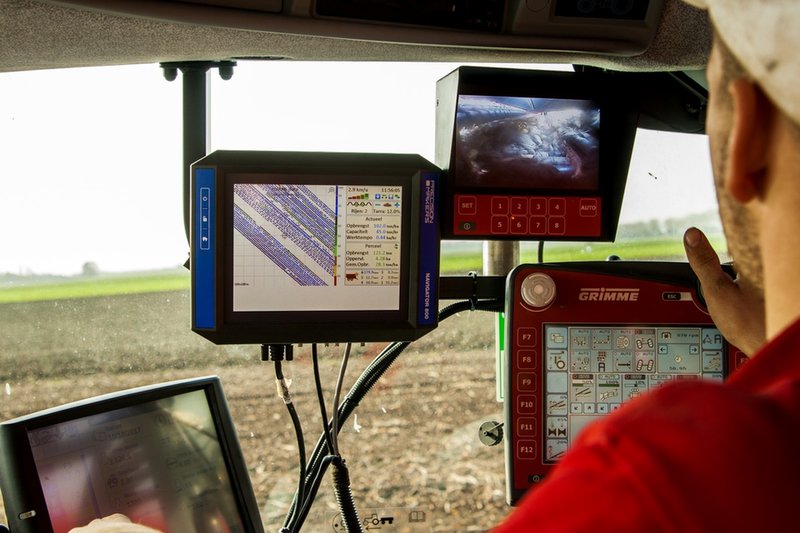event post
what can Blockchain do for Agriculture?
By Peter Rakers

There’s a big chance you have recently read something about blockchain. But what is it? The most straightforward definition can be found in an IBM Limited Edition report(1): “Blockchain is a shared, distributed ledger that facilitates the process of recording transactions and tracking assets in a business network.”
Think of blockchain as a registration system for all kinds of transactions with full transparency on provenance and participants. No regulator or trusted party (e.g. a bank, notary or certifier) is needed. So-called smart contracts are the digital arbitrators to ensure full compliance, privacy and auditability. The core instrument of a blockchain is a digital ledger. This ledger records all transactions across the network and shares it with the participants in a multi-level permission set up. Timestamped ‘blocks’ of immutable information are thus put in a data ‘chain’ matching the right identity of a stakeholder with an action or authorization.
Blockchain in agriculture
Although most of the first blockchain applications were oriented at the financial sector, blockchain technology has potential for the agricultural sector too. According to a recent IBM report(2), agriculture remains the number 1 economic activity in rural areas, but IT only accounts for 1% of all capital spending. Which means there’s a large market to unlock. Present blockchain initiatives in agriculture can be categorized as follows:
- Community-supported or peer-to-peer economic models
Community-supported agriculture (CSA) offers an alternative economic model for the production and distribution of locally-grown food. In fact, the whole idea returns to the historical engagement between farmers and consumers. Today, a shared risk-reward arrangement is added: a community of shareholders funds the activities of a local farm before the growing season starts. In return, they receive a weekly fresh food delivery during harvest. During the growing season, the ledger provides information about the growth status of the crops. Thus the future value of the harvest can be forecasted, while profit and loss are distributed in a fair way.
FarmShare(3) in the US is an example of this new CSA model. The ultimate goal is to create new forms of property ownership, community cooperation, and local self-sufficient economies. FarmShare eliminates the need for logistic and retail partners and shares the risk of a bad harvest between farmer and consumer.
- Transparency in provenance via data monitoring
The combined efforts of IoT and blockchain technology opens a new era of food safety, quality and detailed nutrient information throughout the agri-food production chain.
With recent food scandals in mind, we cannot deny the rising concerns of consumers about the origin of the food they consume. Remarkably, very little research is done on the price elasticity of food products in relation to those concerns, namely: how much more would the consumer be willing to pay in exchange for full transparency of the production and the slaughtering process? It is a relevant question. Blockchain offers the technology to hold stakeholders accountable for their actions in every step of the process. However, how much consumers are willing to pay for this information remains to be seen.
- Reliable and easy-to-use payment systems between farmers and buyers
In combination with the need for transparency in provenance described above, blockchain technology can guarantee correct payments and minimize the risk of fraud. Blockchain logs the necessary information to ensure that what buyers receive as a product is also what they paid for. For example, if you pay for free-range eggs, a blockchain can provide information whether, indeed, the chickens enjoy free range. In such a system, consumers agree to pay somewhat extra for this compliance and the possibility to check in case of doubt. On the other side, the farmer uploads the necessary information genuinely in the shared ledger. In return, he sells the eggs at a higher price.
In a more advanced blockchain set up, normal currencies are replaced with ‘equity shares’ for harvested crops, which only have value within a specific ecosystem. Like this, consumers become shareholders in their local farms. With crop prices being vulnerable to supply and demand fluctuations, poor weather conditions and international market-steered prices, a blockchain eco-system spreads the between producers and consumers.

The future in chains
In August 2017, IBM announced a collaboration with Walmart, Nestlé and Unilever to use blockchain for food safety in a press release(4). It enables food suppliers to source information about the origin, condition and movement of food.
Now that the first prototypes are set up in the field, the next step is to convince the market of their value.
Since 2016, IBM and Walmart have been working together on a pilot study to demonstrate the benefits of tracing food products on blockchain, with “very encouraging” results(5). Frank Yiannas, VP of food safety for Walmart, demonstrated how he could find tracking information using blockchain in 2.2 seconds — a process that used to take almost seven days.
In summary, one can state that blockchain is here to stay. In the coming years, blockchain applications in agriculture will mature. Together with further evolutions in geo-ICT, IoT and AI, blockchain will shape the future of precision farming.
Peter Rakers
Network Manager
ILVO - Smart Digital Farming
peter.rakers@ilvo.vlaanderen.be

- IBM Limited Edition, Manav Gupta: Blockchain for Dummies. © 2017 John Wiley & Sons Inc.
- IBM report: Device Democracy, Saving the Future of the Internet of Things. © 2015 IBM Corporation.
- FarmShare, William E. Bodell III: Blockchain Community-Supported Agriculture.
- Press Release, 24 Aug 2017: IBM deploys blockchain technology to provide enterprise solutions to food safety.
- Wal-Mart Stores, Inc: Annual Shareholders’ Meeting, University of Arkansas, Fayetteville, June 2, 2017.